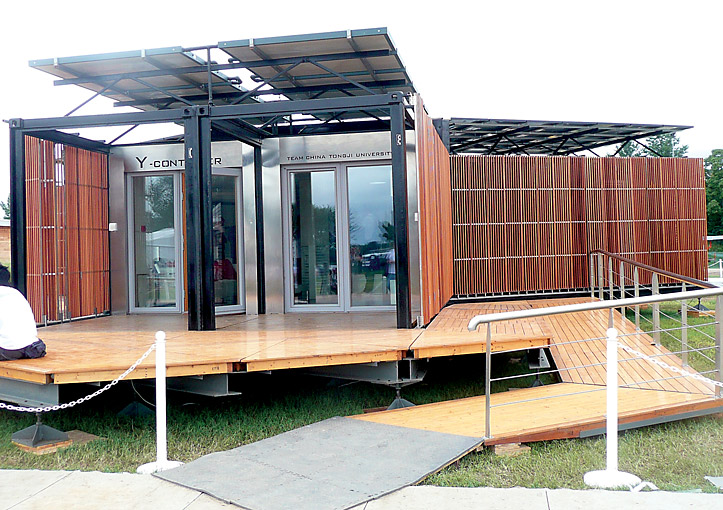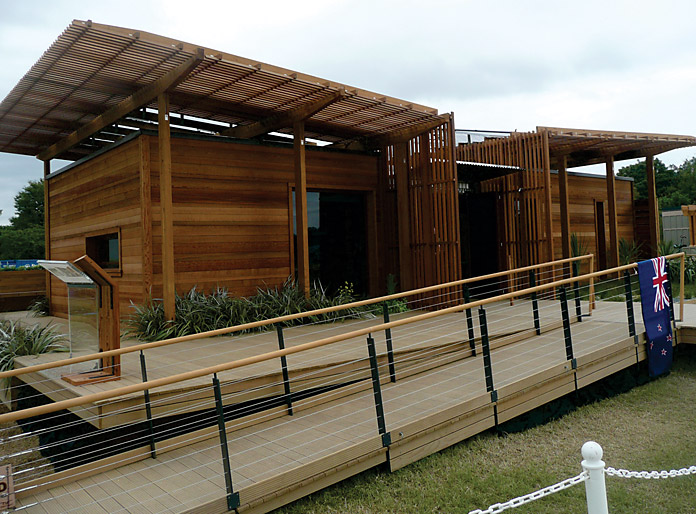Solar Decathlon has wetlands and wool but little sunshine
DOI: 10.1063/PT.3.1329
Nineteen participants in the fifth biennial Solar Decathlon contest in September came to Washington, DC, from as far away as China and New Zealand to showcase their designs for super-efficient homes. Academic teams assembled the fully furnished houses in a muddy park in a matter of days and then carted them away after the 10-day event. Participants were graded on everything from their architecture and engineering to how well the teams could put on a dinner party for eight in their homes. First place overall went to the University of Maryland’s entry, WaterShed, which incorporates an artificial wetland for recycling gray water from sinks and appliances for irrigation, thereby saving potable water. WaterShed’s other features include a saline liquid dessicant to control humidity and reduce the cooling load on heat pumps, a green roof, and a solar thermal water heater that can also provide supplementary heating.
One new criterion this year was affordability: Entries that a professional estimator judged to cost $250 000 or less to build received a perfect score for that category. China’s Tongji University built its Y-shaped home from six shipping containers, but it nonetheless came in 14th in affordability. Teams strived for their homes to produce at least as much energy as they consumed, but over a weeklong stretch in which the Sun rarely emerged, only seven, including Maryland, second-place Purdue University, and third-place New Zealand, met that mark. The Living Light home, by the team from the University of Tennessee, Knoxville, also achieved net-zero energy consumption. It used solar panels manufactured by Solyndra, the California company in the news for its bankruptcy this summer after burning through $535 million in Department of Energy loan guarantees. Aligned on a north–south axis, the cylindrical panels on Living Light’s rooftop orient their photovoltaics to capture sunlight throughout the day, says UT student Lauren Rogers.
Contestants from among 40 applicants were selected by DOE two years ago. Each team received a $100 000 grant to help defray costs. Participants had to specify the market niche they were attempting to meet. The University of Illinois at Urbana-Champaign, for example, designed and built a structure that could be prefabricated and quickly assembled to house victims of natural disasters, says assistant professor of architecture Mark Taylor. The University of Calgary envisioned that its tepee-shaped home could upgrade housing on Indian reservations near that city, and tribal elders were consulted throughout the project, says Johann Kyser, a team member.
The house built by Victoria University of Wellington, in New Zealand, is the first entry in any decathlon from the Southern Hemisphere, boasts team member Nick Officer. Thought to be the only one of the current year’s homes to have been sold, it’s being shipped back to a New Zealand buyer. The house is insulated with a 1-foot-thick layer of wool, a plentiful commodity in a nation where sheep far outnumber humans. Oddly, for a team without engineers—the university has no engineering program—the New Zealand team took first place in the engineering category. Parsons the New School for Design, in New York City, and Stevens Institute of Technology, in Hoboken, New Jersey, joined forces on their Empowerhouse, which the team is installing in an inner-city neighborhood of Washington, DC, in cooperation with Habitat for Humanity.
Team Germany, which won the 2009 and 2007 decathlons, reportedly was put off by the affordability constraint and didn’t participate this year. Just one of the 2009 decathlon houses—Cornell University’s—has actually become a dwelling; most of the others now are showcases on campuses and other public locations. The Ohio State University’s 2009 building currently houses two polar bears at the Columbus Zoo.

To offset the high cost of solar panels, China’s team, from Tongji University, assembled its home from six shipping containers.


The New Zealand entry to the Solar Decathlon was the first ever from the Southern Hemisphere, and the only one known to be sold this year.

More about the Authors
David Kramer. dkramer@aip.org
